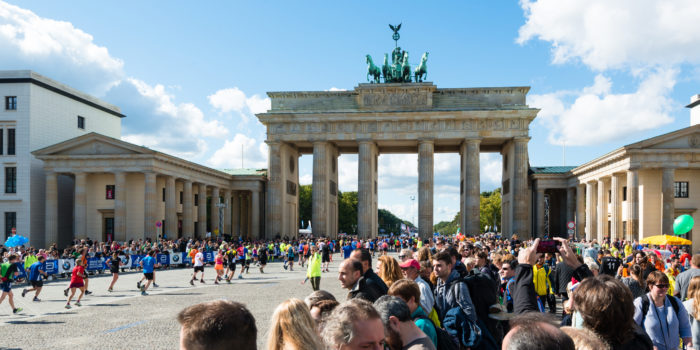Popular running culture tends to reflect the beliefs and priorities of the era that generates it.

The Magic of the Berlin Marathon
The marathon is about being in contention over the last 10K. That’s when it’s about what you have in your core. You have run all the superficial strength and fitness out of yourself and it really comes down to what’s left inside you. To be able to draw deep and pull something out of yourself is one of the most tremendous things about the marathon.”– Rob De Castella
On September 30, 1990, a dream came true. 25,000 runners, many with tears in their eyes, ran through Brandenburg Gate for the first time. The Wall which had brutally divided East Berlin and West Berlin from 1961 to 1989 had come down. Berlin, now joyously reunited into a single city, was holding its first city-wide race. This would be the day the Berlin Marathon established itself among the fastest marathons in the world.
I like to think that the word “unite” can also encompass the merging of heart and mind, breath and movement, trust and training, or even coach and runner. I’ve always loved the way gifted athletes seem to feel the effect of a venue in their bones. An Olympic Stadium, a famous golf course like Augusta National, or a renowned venue like Madison Square Garden can bring a quickening of the spirit, a connection with tradition and a concentration of energies that give performances in these places a heightened quality.
There is no marathon like Berlin.The city once devastated by Allied bombs and divided by the Wall has been reborn as one of the most creative multi-cultural centers in the world. Its trendsetting atmosphere attracts international artists, entrepreneurs, and athletes from across the globe. Berlin’s sporting life, like it’s nightlife, is celebrated as one of the most diverse and vibrant of its kind.
More global records have been broken at Berlin than at any other marathon on earth. Eliud Kipchoge had chased the marathon record in the German capital a few times, but the stars had not aligned for him. Then one Sunday morning last September, in the span of 2:01:39, he changed the sport of running forever. The 33-year-old Kenyan (known as “The Goat” for his remarkable longevity) shattered the former mark by 1 minute – 18 seconds. Kipchoge’s carving 78-seconds off the existing record was the largest improvement in over 50 years.
The facts, figures, and statistics of Eliud’s massive record are astonishing to me. Like most distance world records, Kipchoge’s was achieved by running a negative split. (Of the last ten world records run in the marathon, eight have been run in Berlin and seven of them were achieved with a negative split.) Kipchoge’s 61:06 for the first half and spectacular 60:33 for his second-half sounded imaginary at first. But they were real, and they were beautiful.
When Eliud ran through the Brandenburg Gate (4:29 mile/1:57:34 marathon pace), he saluted the crowd generously, pounded his chest triumphantly, and clapped his hands with glee. Immediately upon crossing the finish line, he dashed into the waiting arms of his trusted coach, Patrick Sang with tears in his eyes, an open expression of their inseparable connection.
Berlin may be the place to run fast, the “The Goat” surely deserves the lion’s share of the credit. His average pace for this marathon was faster than any other human being has ever run for either half of a full marathon. If that isn’t beautiful, nothing is!
Equally admirable is the way the three top women competed in this year’s race, finishing within forty seconds of one another. Gladys Cherono (Kenya) set a new course record with 2:18:11, with Ethiopians, Ruti Aga, runner-up with 2:18:34 and third place Tirusnesh Dibaba finishing 2:18:55, both below the old course record.
I was running my own race, so it didn’t worry me that Tirunesh was in front. My training was good, and when I took over the lead at halfway, I was feeling very strong. I wanted negative splits. I never looked behind, because I was not fearing anybody.” -Gladys Cherono
Of course, runners like Eliud or Gladys are extremely rare. However, while their physiology may represent the pinnacle of evolution, people with normal, everyday bodies can still benefit from their genius.
A race is often won by those who slow down the least. Do you know how to go about running a negative split? How adept are you at pace judgment… especially starting out (miles 1-4)? We’ve all seen how many people start by pushing too hard only to begin running out of steam by that mysterious 15-18 mile zone where things get tough. A 10-second difference in pace per mile can be the difference between a solid finish of 26.2 and a wall splat.



